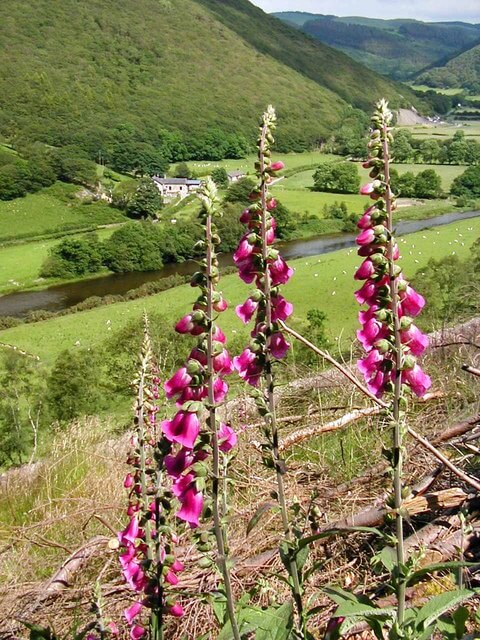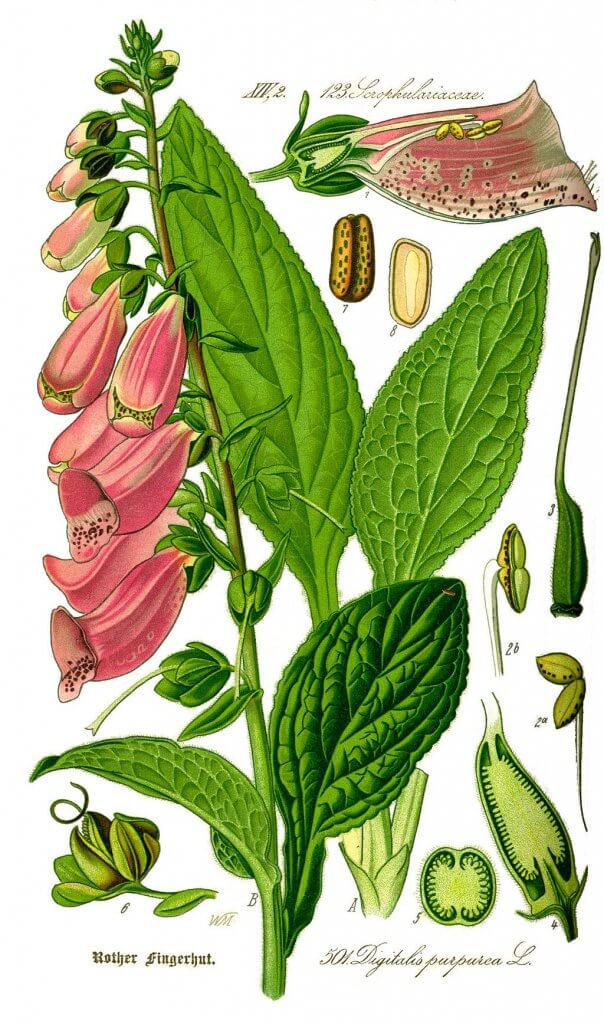Foxglove (Digitalis purpurea) is a plant native to Southwest Europe. It can now be found growing throughout most of Europe and parts of North America. Usually shrub-like in appearance, this biennial plant can be found growing throughout a wide range of habitats. These include coastal areas, rocky slopes, mountainsides, woodlands, and moorland. Areas that have recently been burnt or where the ground has been disturbed will often see foxgloves appearing.
Other common names that you may recognize include common foxglove, purple foxglove, and also lady’s glove. Foxgloves have a very distinctive appearance due to their unique height and flower structures. You will typically find them growing to a height of roughly 1.5 meters, with long flower-covered stems. The compact leaves, arranged in a spiral at the base of the plant, are long, wide, and covered in tiny white hairs. When flowering in early summer, large ornamental flower clusters form in pinks and purples. The flowers are tubular and can reach a length of 10cm.

Cultivation and History of Foxglove
Well-drained soil and full sunlight are the best conditions for growing foxglove. They also tend to prefer oxygenated soil rich in nutrients and moisture. You can grow foxglove from seed, or generally, pick it up from a local garden center or market. As a biennial, the plant will typically last for two years, with flowers appearing during the second year.
Start the seeds outdoors in Fall, or early Spring. Sprinkle the seeds lightly over the soil and press firmly. They need light to germinate so do not press them too deep. When they begin to mature and flower, you may need to use a stake to support the plant.
Some garden centers will sell a range of cultivated colors including white, rose pink, and yellow. Some varieties have also been bred to flower for longer, so could be considered perennial. These varieties generally lack the height of more wild species.
Foxglove is cultivated for its uses within the pharmaceutical industry. The leaves are harvested and will undergo a distillation process to extract the medicinal substances.

Toxicity
Foxglove is an extremely toxic plant. Leaves, flowers, roots, and stem should not be consumed. Children and pets should be supervised if you choose to plant this within your garden. Symptoms of foxglove poisoning include dizziness, nausea, irregular pulse, convulsions and muscle weakness. Particularly vulnerable individuals may be at risk of death, if foxglove is consumed.
Uses
Culinary uses of Foxglove
Foxglove cannot be used within food recipes or dishes due to its toxicity. The leaves have a very bitter taste which hints at the toxic chemicals found within. Throughout history, foxglove has been regarded as a plant that should be avoided. That is until William Withering discovered its potential for treating heart conditions.

Medicinal uses of Foxglove
Certain substances found within foxglove have been noted for their ability to effectively treat some heart conditions. These toxins are called digitoxin and digoxin. However, these heart conditions must not be self treated. The substances needed can only be safely extracted by a complex distilling procedure.
Did you know…
Foxgloves have the ability to produce up to 2 million seeds within their relatively short lifetimes. As they are self-seeding, this gives them the ability to spread very quickly!
Conclusion
Foxgloves are sure to give your garden a ‘cottage garden’ feel. They have an incredibly ornamental and beautiful structure. However, care must be taken if your garden is frequented by pets or young children. The plant is extremely poisonous when consumed so care must be taken. Bees and other pollinators are particularly attracted to foxglove, so planting them near other plants may encourage pollination and better growth.
—————Written by Hannah Sweet
Hannah is a freelance writer and graphic designer from the UK. With a penchant for travelling, photography and all things botanical, she enjoys writing about a wealth of topics and issues, from conservation and slow living, to design and travel. Learn more about her writing and design services at www.sweetmeanders.co
Many of our readers find that subscribing to Eat The Planet is the best way to make sure they don't miss any of our valuable information about wild edibles.
See our privacy policy for more information about ads on this site







One Response
Beautiful flowers, but I’m only interested in planting vegetation that is edible to me and wildlife. Of course, flowers are good for the bees, butterflies, and humming birds.